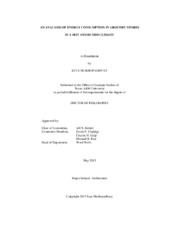| dc.contributor.advisor | Haberl, Jeff | |
| dc.creator | Mukhopadhyay, Jaya | |
| dc.date.accessioned | 2013-10-03T14:44:00Z | |
| dc.date.available | 2013-10-03T14:44:00Z | |
| dc.date.created | 2013-05 | |
| dc.date.issued | 2013-04-09 | |
| dc.date.submitted | May 2013 | |
| dc.identifier.uri | https://hdl.handle.net/1969.1/149403 | |
| dc.description.abstract | The intent of this study was to investigate the efficient use of energy by developing an energy efficient grocery store combined with cogeneration. This study demonstrated the potential to reduce the energy use in buildings, by implementing a decentralized source of energy generation that allowed for the use of a portion of the energy generated to be shared across building boundaries.
This study considered a high energy use building such as a grocery store to be a part of a residential community, which could potentially participate in the sharing of energy across building boundaries. To better utilize energy resources the study proposed the implementation of a cogeneration facility to supply energy primarily to the store. Surplus energy generated by this cogeneration system was then shared with the requirements of the surrounding residential community. Finally, in order to better account for energy consumption of these buildings both site and source energy was considered. The study focused on hot and humid climates. This study was presented in two parts: Analyzing conventional grocery store systems to determine the maximum savings possible; and examining the option of co-generation systems to provide power to grocery stores and a portion of the community in order to reduce source energy use for the grocery store and a portion of the surrounding community.
Source energy savings were in the range of 47% to 54% depending on the energy efficiency measures selected and the cogeneration configuration determined in the grocery store. Economic payback periods in the range of 4 to 7 years (time until zero net present value) were observed. The selection of appropriate options was narrowed down to two options that utilized more thermal energy within the boundaries of the store and generated more amount of surplus energy to be absorbed by the neighboring residential buildings. | en |
| dc.format.mimetype | application/pdf | |
| dc.language.iso | en | |
| dc.subject | Energy Efficiency | en |
| dc.subject | Cogeneration | en |
| dc.subject | Climate | en |
| dc.title | An Analysis of Energy Consumption in Grocery Stores in a Hot and Humid Climate | en |
| dc.type | Thesis | en |
| thesis.degree.department | Architecture | en |
| thesis.degree.discipline | Architecture | en |
| thesis.degree.grantor | Texas A&M University | en |
| thesis.degree.name | Doctor of Philosophy | en |
| thesis.degree.level | Doctoral | en |
| dc.contributor.committeeMember | Claridge, David | |
| dc.contributor.committeeMember | Culp, Charles | |
| dc.contributor.committeeMember | Pate, Michael | |
| dc.type.material | text | en |
| dc.date.updated | 2013-10-03T14:44:00Z | |


